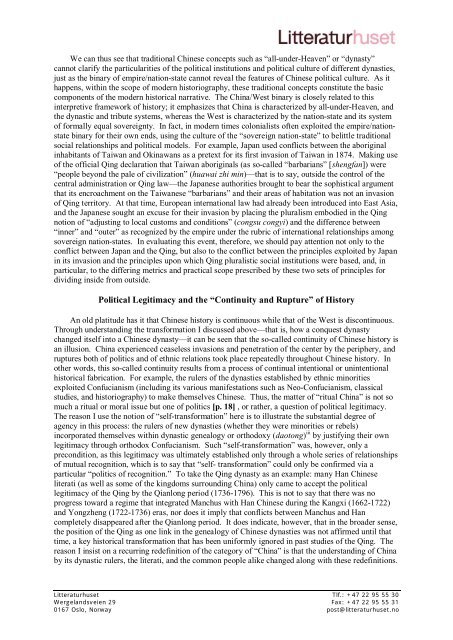20 2011 Opening speech by Prof. Wang Hui ... - Litteraturhuset
20 2011 Opening speech by Prof. Wang Hui ... - Litteraturhuset
20 2011 Opening speech by Prof. Wang Hui ... - Litteraturhuset
You also want an ePaper? Increase the reach of your titles
YUMPU automatically turns print PDFs into web optimized ePapers that Google loves.
We can thus see that traditional Chinese concepts such as “all-under-Heaven” or “dynasty”cannot clarify the particularities of the political institutions and political culture of different dynasties,just as the binary of empire/nation-state cannot reveal the features of Chinese political culture. As ithappens, within the scope of modern historiography, these traditional concepts constitute the basiccomponents of the modern historical narrative. The China/West binary is closely related to thisinterpretive framework of history; it emphasizes that China is characterized <strong>by</strong> all-under-Heaven, andthe dynastic and tribute systems, whereas the West is characterized <strong>by</strong> the nation-state and its systemof formally equal sovereignty. In fact, in modern times colonialists often exploited the empire/nationstatebinary for their own ends, using the culture of the “sovereign nation-state” to belittle traditionalsocial relationships and political models. For example, Japan used conflicts between the aboriginalinhabitants of Taiwan and Okinawans as a pretext for its first invasion of Taiwan in 1874. Making useof the official Qing declaration that Taiwan aboriginals (as so-called “barbarians” [shengfan]) were“people beyond the pale of civilization” (huawai zhi min)—that is to say, outside the control of thecentral administration or Qing law—the Japanese authorities brought to bear the sophistical argumentthat its encroachment on the Taiwanese “barbarians” and their areas of habitation was not an invasionof Qing territory. At that time, European international law had already been introduced into East Asia,and the Japanese sought an excuse for their invasion <strong>by</strong> placing the pluralism embodied in the Qingnotion of “adjusting to local customs and conditions” (congsu congyi) and the difference between“inner” and “outer” as recognized <strong>by</strong> the empire under the rubric of international relationships amongsovereign nation-states. In evaluating this event, therefore, we should pay attention not only to theconflict between Japan and the Qing, but also to the conflict between the principles exploited <strong>by</strong> Japanin its invasion and the principles upon which Qing pluralistic social institutions were based, and, inparticular, to the differing metrics and practical scope prescribed <strong>by</strong> these two sets of principles fordividing inside from outside.Political Legitimacy and the “Continuity and Rupture” of HistoryAn old platitude has it that Chinese history is continuous while that of the West is discontinuous.Through understanding the transformation I discussed above—that is, how a conquest dynastychanged itself into a Chinese dynasty—it can be seen that the so-called continuity of Chinese history isan illusion. China experienced ceaseless invasions and penetration of the center <strong>by</strong> the periphery, andruptures both of politics and of ethnic relations took place repeatedly throughout Chinese history. Inother words, this so-called continuity results from a process of continual intentional or unintentionalhistorical fabrication. For example, the rulers of the dynasties established <strong>by</strong> ethnic minoritiesexploited Confucianism (including its various manifestations such as Neo-Confucianism, classicalstudies, and historiography) to make themselves Chinese. Thus, the matter of “ritual China” is not somuch a ritual or moral issue but one of politics [p. 18] , or rather, a question of political legitimacy.The reason I use the notion of “self-transformation” here is to illustrate the substantial degree ofagency in this process: the rulers of new dynasties (whether they were minorities or rebels)incorporated themselves within dynastic genealogy or orthodoxy (daotong) iii <strong>by</strong> justifying their ownlegitimacy through orthodox Confucianism. Such “self-transformation” was, however, only aprecondition, as this legitimacy was ultimately established only through a whole series of relationshipsof mutual recognition, which is to say that “self- transformation” could only be confirmed via aparticular “politics of recognition.” To take the Qing dynasty as an example: many Han Chineseliterati (as well as some of the kingdoms surrounding China) only came to accept the politicallegitimacy of the Qing <strong>by</strong> the Qianlong period (1736-1796). This is not to say that there was noprogress toward a regime that integrated Manchus with Han Chinese during the Kangxi (1662-1722)and Yongzheng (1722-1736) eras, nor does it imply that conflicts between Manchus and Hancompletely disappeared after the Qianlong period. It does indicate, however, that in the broader sense,the position of the Qing as one link in the genealogy of Chinese dynasties was not affirmed until thattime, a key historical transformation that has been uniformly ignored in past studies of the Qing. Thereason I insist on a recurring redefinition of the category of “China” is that the understanding of China<strong>by</strong> its dynastic rulers, the literati, and the common people alike changed along with these redefinitions.<strong>Litteraturhuset</strong> Tlf.: +47 22 95 55 30Wergelandsveien 29 Fax: +47 22 95 55 310167 Oslo, Norway post@litteraturhuset.no



